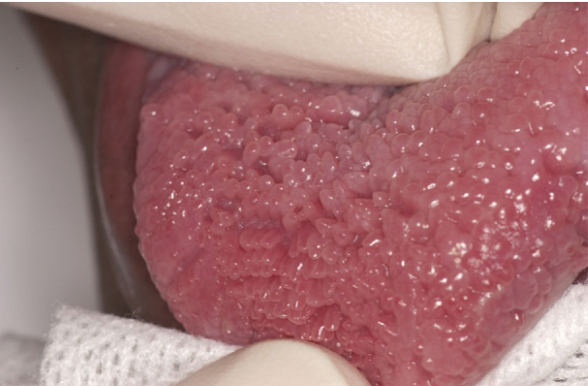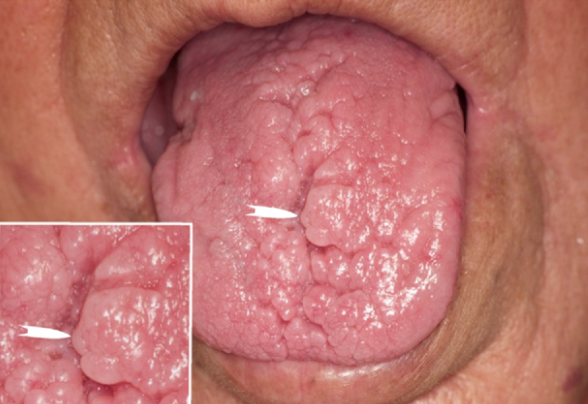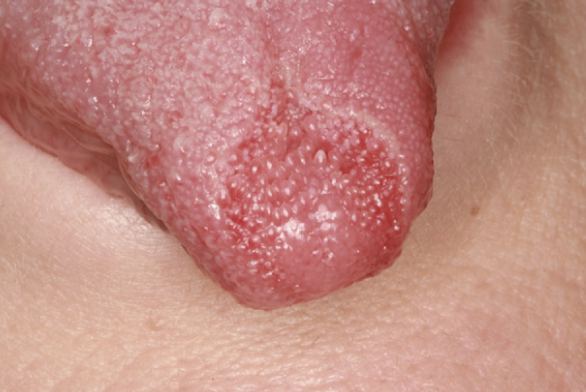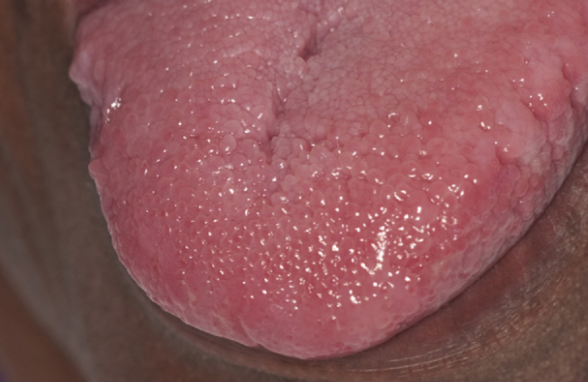A very common finding in patients is the “spontaneous” enlargement of fungiform papillae, called transient lingual papulosis. These enlargements are erythematous and develop 1-4 hours following a source of trauma, such as heat, spicy foods, or mechanical trauma. These cases are usually very painful. The good news is that they almost always resolve by themselves 1-4 days after their first occurrence.
Fun fact, transient lingual papulosis has traditionally been called “liar’s tongue,” forming after you have been caught in a lie. 🙂
Until 2012, there were never any recorded cases of a chronic variant of this type of papulosis. Here, we present those recorded cases, newly termed: “Chronic Lingual Papulosis (CLP).” These cases of papulosis have been present for many years, all of which are asymptomatic.
Pic 2: Diffuse, bilateral involvement of much of the dorsal surface, with considerable variation in size of papules and with some papules showing mild pallor from hyperkeratosis. Arrow showing biopsied area.
Pic 3: Tip of tongue shows diffuse enlargement of most papillae, with some showing a somewhat transparent appearance.
Pic 4: Most papillae of the tip of the tongue are enlarged and some seem slightly edematous. Papules extend onto the anterior dorsum and crenations are seen on the lateral borders.
Diagnosis:
- CLP appears typically to be a fibrous hyperplastic response of filiform and sometimes fungiform papillae to mild mechanical irritation, low-grade, long-term inflammation or chronic desiccation.
- CLP duration is far too long, is not associated with change over time, and, moreover, none of the patients had ever painful papulosis.
- Characterized by multiple (dozens, at least) asymptomatic, normal-colored, enlarged lingual papillae, composed microscopically of dense fibrous tissue with few, if any, inflammatory cells.
- The abnormality may have an adult or childhood onset, perhaps with different etiologic factors at work, and the papules may be clustered or generalized.
CLP and General Health:
- CLP is, by definition, not associated with any of the numerous systemic diseases or syndromes presenting with multiple lingual papules or nodules.
- CLP appears to be innocuous in its biological behavior and requires no treatment, unless secondarily infected by Candida in the furrows surrounding the papules.
- Biopsy should not be required unless the enlarged papillae appear atypical.
Today’s Morning Huddle was brought to you by Jerry E. Bouquot et al.






